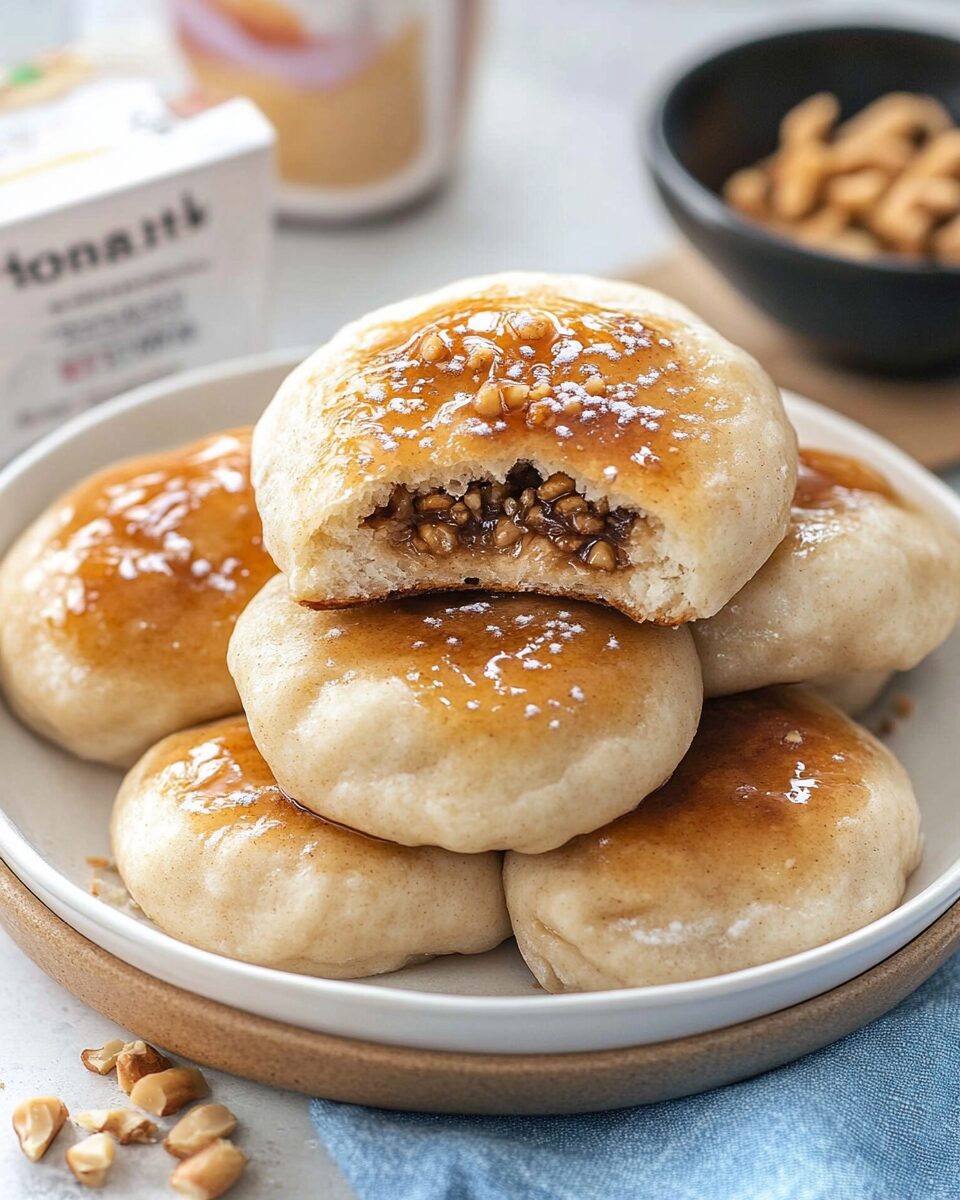Hotteok is a popular Korean street snack, known for its soft, chewy dough filled with a sweet and gooey filling. It is typically served hot, making it a perfect treat for cold weather. The filling usually consists of brown sugar, cinnamon, and nuts, creating a deliciously sweet and crunchy bite. This recipe is perfect for satisfying your sweet tooth with a crispy exterior and a warm, gooey center.
FULL RECIPE
Ingredients
- 2 cups all-purpose flour
- 2 tablespoons sugar
- 1 teaspoon active dry yeast
- 1/2 teaspoon salt
- 1/2 cup warm water
- 1 tablespoon vegetable oil
- 1/2 cup brown sugar
- 1/4 cup chopped walnuts or peanuts
- 1 teaspoon ground cinnamon
- 1 tablespoon butter (for frying)
Directions
- In a bowl, combine warm water, sugar, and yeast. Let sit for about 5 minutes, until the yeast is activated and frothy.
- In a separate bowl, mix flour and salt. Add the yeast mixture and vegetable oil, then stir to combine. Knead the dough for about 5 minutes until smooth. Cover and let rise for 1 hour or until doubled in size.
- While the dough is rising, prepare the filling by combining brown sugar, cinnamon, and chopped nuts in a bowl.
- Once the dough has risen, divide it into 8 equal portions and roll each portion into a ball.
- Flatten each ball into a disk and place a spoonful of the filling in the center. Pinch the edges to seal the dough around the filling.
- Heat a skillet over medium heat and melt the butter. Place the filled dough balls in the skillet and cook for 3-4 minutes on each side, pressing down gently to ensure the filling melts inside.
- Serve hot, enjoying the crispy exterior and gooey, sweet filling.
Nutritional Information
- Calories: 220 per serving
- Fat: 10g
- Carbohydrates: 30g
- Protein: 3g
- Fiber: 2g
- Sugar: 15g
The History Behind Hotteok
Hotteok’s origins trace back to the late 19th century during the Joseon Dynasty. It is said to have been introduced by Chinese immigrants who brought their version of filled pancakes to Korea. The dish became popular due to its affordability and warmth, making it perfect for winter. Over time, the Korean version evolved, with the filling becoming sweeter and incorporating local ingredients like walnuts and peanuts.
How Hotteok Became a Street Food Phenomenon
Hotteok became a well-known street food in Korea by the 20th century. As urbanization grew, vendors started selling hotteok in markets, fairs, and street corners, capitalizing on its warm and satisfying qualities. During the winter, it is a common sight to see people lining up for hotteok, eager to enjoy the treat as they walk through the streets. The snack has also gained popularity outside of Korea, becoming a favorite for Korean food enthusiasts worldwide.
Types of Hotteok
While the traditional hotteok consists of brown sugar, cinnamon, and nuts, there are many variations of this treat. Some vendors may use honey, chocolate, or even sweet red bean paste as fillings. Regional variations also exist, with some versions incorporating fruits or other local ingredients. The dough can also be adapted, using sweet potatoes, for instance, to create a different texture and flavor.
The Role of Yeast in Hotteok Dough
The dough used for hotteok is leavened with yeast, which gives it a soft, chewy texture. Yeast allows the dough to rise, creating a light and airy consistency, which contrasts beautifully with the crunchy, caramelized exterior once fried. The activation of yeast is a critical part of the dough-making process, ensuring that the dough rises properly and creates the perfect texture.
The Importance of the Filling
The filling of hotteok is what sets it apart from other snacks. The combination of brown sugar and cinnamon gives the filling its signature sweetness and warmth. The addition of chopped nuts like walnuts or peanuts adds a crunchy texture, balancing the soft dough and enhancing the overall flavor. The filling is typically made in advance, allowing it to solidify slightly before being stuffed into the dough.
How to Achieve the Perfect Hotteok Texture
The texture of hotteok is crucial to its appeal. The dough must be soft and pillowy on the inside, with a crisp and golden-brown exterior. To achieve this, it’s important to let the dough rise properly and to cook it on medium heat so that it fries evenly without burning. Pressing down gently on the dough while cooking also helps achieve a thin, crisp outer layer.
Frying Hotteok: The Secret to Crispiness
The frying process is where hotteok really comes to life. A skillet or pan should be preheated with butter or oil to ensure that the dough cooks evenly. The heat should be moderate, as high heat can burn the dough before the filling has time to melt. The key to achieving that signature crispy exterior is to press down gently on the dough while it fries, allowing the sugar inside to caramelize and create a delicious crunch.
Cultural Significance of Hotteok in Korea
In Korea, hotteok is more than just a snack; it is a part of the culture. The snack is often associated with the winter season, particularly during the New Year and Seollal (Korean Lunar New Year) celebrations. It is a comfort food, offering warmth and satisfaction in the chilly weather. For many, hotteok brings back memories of childhood or time spent with family and friends during holidays.
Hotteok in Popular Korean Cuisine
Hotteok is considered a part of traditional Korean street food, which also includes other well-known snacks like tteokbokki (spicy rice cakes) and odeng (fish cake skewers). Like these other dishes, hotteok is an affordable treat that can be enjoyed by people of all ages. Its place in Korean cuisine is firmly cemented, and it is a must-try for anyone looking to explore the country’s food culture.
Hotteok’s Popularity Outside Korea
Thanks to the growing popularity of Korean cuisine worldwide, hotteok has found a fanbase in many countries. Many Korean restaurants and street food vendors outside Korea serve hotteok, introducing it to a new audience. The rise of social media has also helped spread the word about this tasty treat, with food bloggers and enthusiasts sharing their experiences and recipes with followers around the globe.
Making Hotteok at Home: A Fun Cooking Experience
Making hotteok at home can be a fun and rewarding cooking experience. While it may seem intimidating at first, the process is simple and straightforward once the dough and filling are prepared. The best part is that you can customize the filling to suit your taste, experimenting with different combinations of spices, nuts, and sweeteners. Cooking hotteok from scratch allows you to enjoy the snack fresh, straight off the skillet.
Hotteok for Special Occasions
Although hotteok is often associated with street food and casual snacking, it can also be served for special occasions. For instance, it can be a fun addition to a Korean-themed party or a comforting treat during the colder months. Because of its simple yet satisfying nature, hotteok is also perfect for casual gatherings, family meals, or even as a thoughtful homemade gift for friends and loved ones.
Healthier Alternatives for Hotteok Fillings
While the traditional hotteok filling is deliciously sweet and indulgent, there are ways to make it a little healthier without sacrificing flavor. You can reduce the amount of sugar used and replace it with honey or maple syrup. Additionally, nuts such as almonds or cashews can be used instead of walnuts for a different texture. Adding dried fruits like raisins or cranberries can also introduce natural sweetness and fiber into the filling.
How to Store Leftover Hotteok
If you happen to have leftover hotteok, you can store it in an airtight container at room temperature for up to two days. If you want to keep it fresh for longer, freezing hotteok is a great option. Wrap each piece individually in plastic wrap, then place them in a freezer bag. When ready to eat, simply reheat the hotteok in a skillet or microwave for a few seconds until warm.
Serving Hotteok: Pairing with Drinks
Hotteok pairs wonderfully with a variety of beverages. For a traditional experience, enjoy your hotteok with a warm cup of Korean tea, such as barley tea or green tea. If you’re in the mood for something sweeter, try pairing it with a glass of milk or a hot chocolate. The contrast of the warm, gooey filling with the cold drink makes for a perfect combination.
Hotteok as a Breakfast Option
Though hotteok is typically consumed as a snack or dessert, it can also be enjoyed as a breakfast option. The dough is hearty and filling, providing a satisfying start to the day. Paired with a hot drink or some fresh fruit, hotteok makes for a comforting and balanced meal to begin your morning.
The Global Influence of Korean Street Food
The rise of K-pop and Korean culture around the world has brought many aspects of Korean life into the global spotlight, including food. Korean street food, including hotteok, is now enjoyed in many parts of the world. Korean food festivals and pop-up markets offer hotteok alongside other traditional dishes, making it a great way to introduce people to the flavors of Korea.
Hotteok as a Symbol of Korean Hospitality
In Korean culture, food plays a significant role in hospitality. Hotteok is often shared among friends and family, symbolizing warmth and togetherness. The act of making hotteok at home can be seen as an expression of care, with the cook offering a warm and delicious snack to those around them. In this sense, hotteok is more than just a tasty treat; it is a gesture of kindness and hospitality.
Conclusion
Hotteok remains a timeless snack that holds a special place in the hearts of many. Its simple yet delicious combination of sweet, gooey filling and crispy dough has made it a staple in Korean street food culture. Whether enjoyed as a snack, dessert, or even a breakfast, hotteok continues to delight people of all ages. Its popularity has transcended borders, and it is now enjoyed worldwide. Making hotteok at home allows you to experience this beloved treat in its freshest form, bringing a taste of Korea into your own kitchen.






